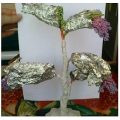
Imprints of plants on accessories in the interior: detailed workshops with photos on making an eco print
In almost any interior you can findplants. It can be both living indoor flowers, and various paintings with a floral print. But there are few who can be surprised. Homemade paintings, curtains and pillows with imprints of natural plants will look much more surprising. We offer to consider interesting and detailed master classes on their manufacture.  Country tablecloth with eco print from natural plants
Country tablecloth with eco print from natural plants
Pillows, bags and other textiles with prints of plants
The easiest way to transfer the imprint of the plant to the fabric(there’s a hot and cold way for this, you will find detailed master classes below), and then use this fabric as you wish, for example, sew a dryer or a cover onto a sofa cushion, make a tablecloth or path onto a table or sew original curtains on windows. And since it is quite simple, it will also be a great option as a DIY gift. 



Imprints of plants on clay
 Imprints in clay do it yourselfplants in clay are no more difficult than on fabric, although it takes a little longer. The main thing here is to choose the right clay. The most ordinary one will work, but if you do some small things, for example, jewelry or dishes, then something decorative is better, for example, polymer for jewelry or self-freezing (keraplast) for dishes. Next, you need to roll a clay sheet with a rolling pin to make a plate about 3-6 cm thick (it depends on the clay you have chosen). Next, take plants, even fresh, at least defrosted (keep in mind that from fresh plants the pattern will be brighter and clearer). Having decomposed the plants in the right way, we roll it out again with a rolling pin, creating an imprint. Then the plants themselves are removed, the stuck pieces are removed with tweezers and the clay base is allowed to dry.
Imprints in clay do it yourselfplants in clay are no more difficult than on fabric, although it takes a little longer. The main thing here is to choose the right clay. The most ordinary one will work, but if you do some small things, for example, jewelry or dishes, then something decorative is better, for example, polymer for jewelry or self-freezing (keraplast) for dishes. Next, you need to roll a clay sheet with a rolling pin to make a plate about 3-6 cm thick (it depends on the clay you have chosen). Next, take plants, even fresh, at least defrosted (keep in mind that from fresh plants the pattern will be brighter and clearer). Having decomposed the plants in the right way, we roll it out again with a rolling pin, creating an imprint. Then the plants themselves are removed, the stuck pieces are removed with tweezers and the clay base is allowed to dry. 


 Main feature: we need a convex relief, not a bulge in clay, how can we get it? Very simple. We roll out a new sheet of clay with a rolling pin, put it on top of the first, already frozen base, roll it out and get a convex ornament - it remains to let it dry. Cut the desired shape with a cutter, smooth the edges with the skin and give the desired shape. You can tint to paint or even coat with resin - relevant for jewelry, so as not to break the resulting masterpiece.
Main feature: we need a convex relief, not a bulge in clay, how can we get it? Very simple. We roll out a new sheet of clay with a rolling pin, put it on top of the first, already frozen base, roll it out and get a convex ornament - it remains to let it dry. Cut the desired shape with a cutter, smooth the edges with the skin and give the desired shape. You can tint to paint or even coat with resin - relevant for jewelry, so as not to break the resulting masterpiece. 



What to make of such prints?
 Clay paintings with prints of plantssimple - paintings on the walls. Some artists specialize only in such clay paintings with prints of grass and flowers, decorating them not only with their house and apartment, but also making gifts for friends, or even opening a small shop on the Internet. DIY imprints of plants in clay
Clay paintings with prints of plantssimple - paintings on the walls. Some artists specialize only in such clay paintings with prints of grass and flowers, decorating them not only with their house and apartment, but also making gifts for friends, or even opening a small shop on the Internet. DIY imprints of plants in clay  Clay jewelry with prints of plants
Clay jewelry with prints of plants 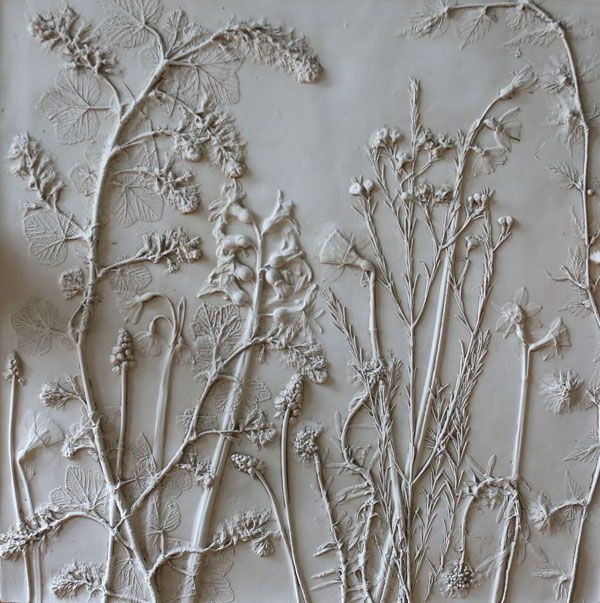


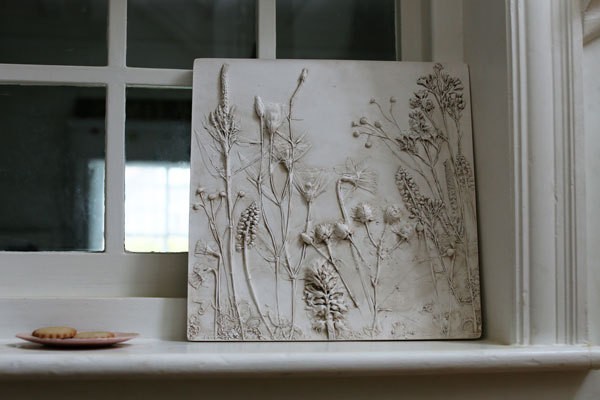 But rectangular paintings are pretty boring andcan get tired quickly. But there are more original options. For example, why not make yourself designer dishes with your own fingerprints? Or voluminous clay leaves? The beginning is the same as when creating the picture. Next, you need to bend the clay, giving the plate or dish the final shape and let it harden. The technology is still the same, you can leave both the convex and the original version of the extruded print, covered with resin on top to create a flat surface.
But rectangular paintings are pretty boring andcan get tired quickly. But there are more original options. For example, why not make yourself designer dishes with your own fingerprints? Or voluminous clay leaves? The beginning is the same as when creating the picture. Next, you need to bend the clay, giving the plate or dish the final shape and let it harden. The technology is still the same, you can leave both the convex and the original version of the extruded print, covered with resin on top to create a flat surface.  Unusual plate in the prints of plants
Unusual plate in the prints of plants 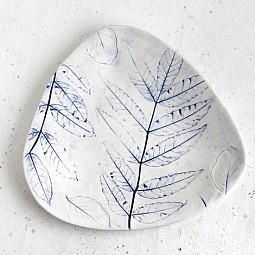


 Another option for small clayround circles or rectangles - it is also simple to make, and how to use them in the decor - think for yourself. For example, From rectangles or squares, you can make a design panel by decorating a frame for a photograph or for a mirror. You can also make decorations, curtains on windows, wind music for garden decor and much more - it depends on your imagination:
Another option for small clayround circles or rectangles - it is also simple to make, and how to use them in the decor - think for yourself. For example, From rectangles or squares, you can make a design panel by decorating a frame for a photograph or for a mirror. You can also make decorations, curtains on windows, wind music for garden decor and much more - it depends on your imagination:  Making a panel of clay plates
Making a panel of clay plates 


 Pictures of plants and their prints in plasterTransferring the print of a plant to paper is simpler - much easier than drawing it yourself, which means that even if you don’t have artistic talents, you can easily make eco-prints that will decorate your living room, kitchen or your workplace. There are several ways to create such a picture. For example, a print with multi-colored paints:
Pictures of plants and their prints in plasterTransferring the print of a plant to paper is simpler - much easier than drawing it yourself, which means that even if you don’t have artistic talents, you can easily make eco-prints that will decorate your living room, kitchen or your workplace. There are several ways to create such a picture. For example, a print with multi-colored paints:  A print from plant prints
A print from plant prints 


 The second option - to draw pictures with prints in the form of a herbarium - you can use both living plants and their prints on paper.
The second option - to draw pictures with prints in the form of a herbarium - you can use both living plants and their prints on paper.  Pictures of plant prints in the interior
Pictures of plant prints in the interior 



 C
C 


Fashionable eco-print in the interior
First you need to figure out what thisprocedure. Ecoprint is an imprint on a fabric or other surface using natural plant juice. No other dyes are used. Ecoprint can be done in two ways:
- cold;
- hot.
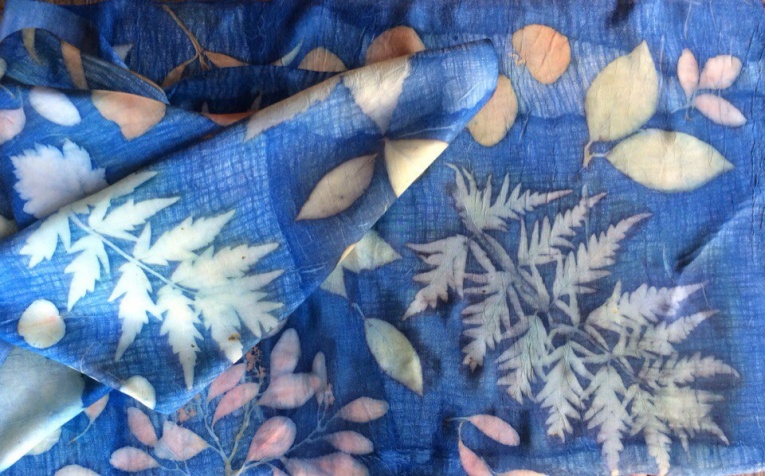 Fabric with the imprint of natural plants for needlework. Plants such as:
Fabric with the imprint of natural plants for needlework. Plants such as:
- oak;
- alder;
- Birch tree;
- clover;
- fern;
- sagebrush;
- horse sorrel;
- nettle.
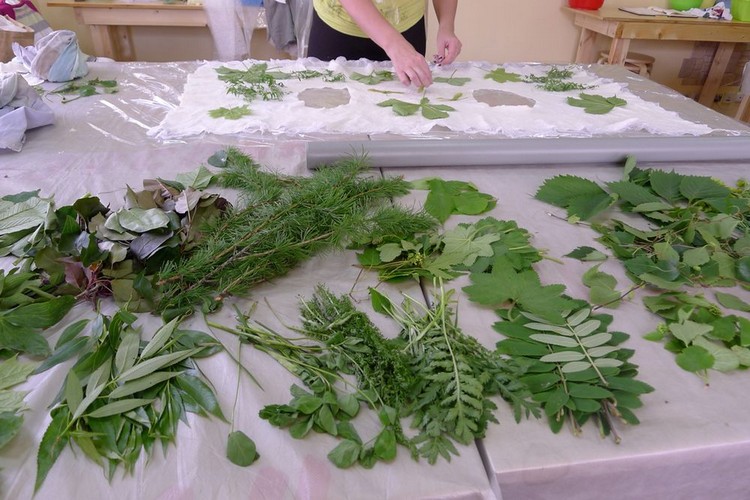 Plants for making eco prints Alsosome craftsmen use berries and flowers for prints. The latter are not considered the most successful materials for dyeing fabric. Natural dyeing in eco-print style has recently become very fashionable and popular, especially among those people who care about the environment. And the use of pillows and curtains sewn from such a fabric in the interior of the house is very stylish.
Plants for making eco prints Alsosome craftsmen use berries and flowers for prints. The latter are not considered the most successful materials for dyeing fabric. Natural dyeing in eco-print style has recently become very fashionable and popular, especially among those people who care about the environment. And the use of pillows and curtains sewn from such a fabric in the interior of the house is very stylish.  Blanks for napkins with eco print “Pansies”. Any fabric can be used for staining. Now you need to consider in more detail all the techniques for applying plant prints to tissue.
Blanks for napkins with eco print “Pansies”. Any fabric can be used for staining. Now you need to consider in more detail all the techniques for applying plant prints to tissue. 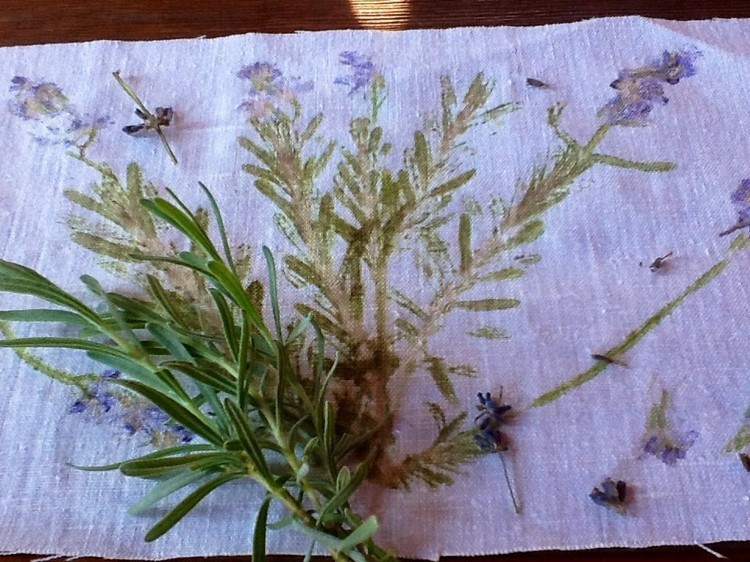 Fabric with imprint of plants and flowers
Fabric with imprint of plants and flowers
Imprint of plants on fabric in the interior in a cold way
This method is done without heating the fabric. Plants and flowers are simply wrapped in material. This method of work is long. To get a positive result, you will have to wait from a week to a couple of months.  Pillows made in the cold plant imprinting technique
Pillows made in the cold plant imprinting technique
Imprint of plants on fabric in the interior in a hot way
This method is more complex and long, while onEach stage of the work has its own nuances. In this method, tissue with plants is heated, after which amazing patterns are created, created almost by nature itself. The imprint of plants on the fabric in a hot way is very persistent. In most cases, even superior to artificial dyes. 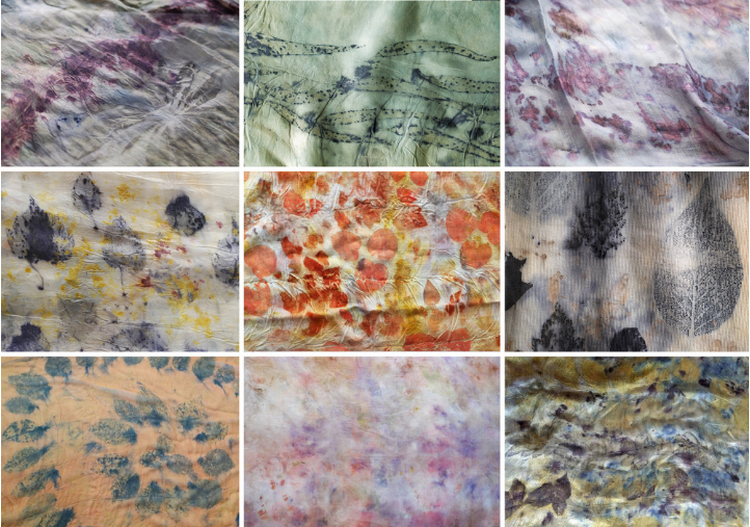 Natural fabrics dyed alsohot ecoprint technique is also called contact staining. Thanks to it, each wrapped plant leaves its indelible mark, aroma and useful properties on the fabric.
Natural fabrics dyed alsohot ecoprint technique is also called contact staining. Thanks to it, each wrapped plant leaves its indelible mark, aroma and useful properties on the fabric. 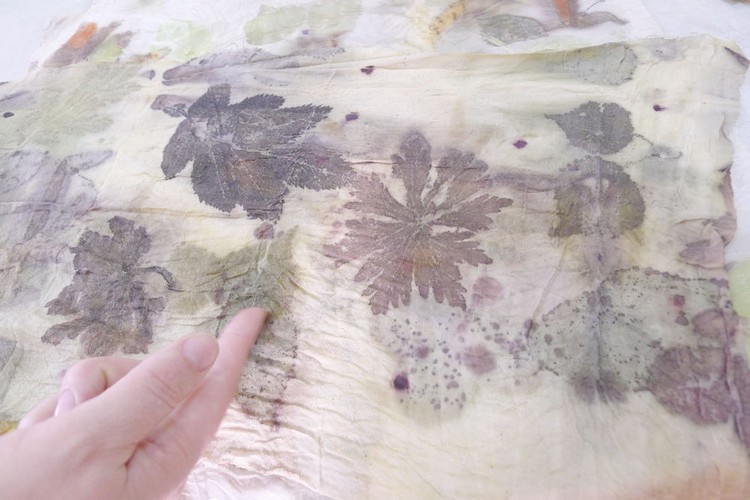 Eco-print made by a hot print of plants. In any eco-print, whether it is cold or hot, there is always some element of surprise. The end result depends on many factors:
Eco-print made by a hot print of plants. In any eco-print, whether it is cold or hot, there is always some element of surprise. The end result depends on many factors:
- where and at what time various plants were collected;
- what fabric is used for prints;
- whether the fabric has passed preliminary preparation for dyeing;
- water quality;
- your mood.
Even the final result will depend on your mood. Do not be surprised at what you did. Natural patterns will turn out original with interesting color transitions. 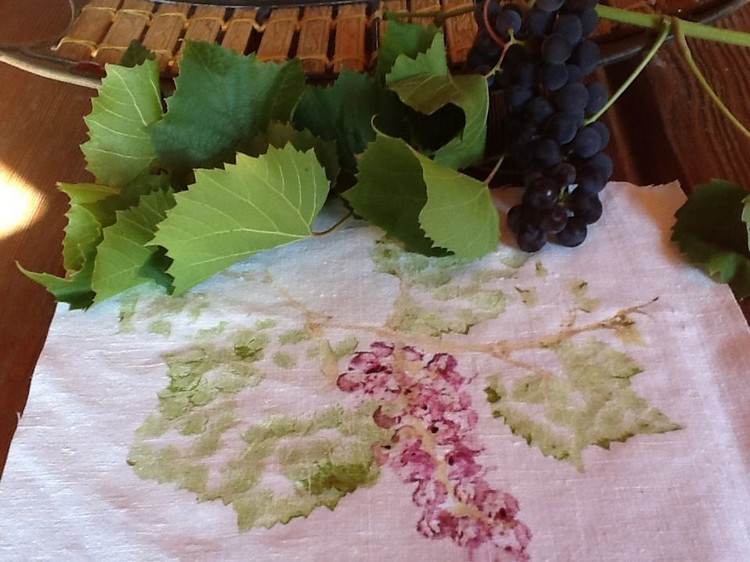 Imprint of grapes on the fabric Now it’s worth moving on to the master classes.
Imprint of grapes on the fabric Now it’s worth moving on to the master classes.
Master class: imprint of plants on fabric using a hot method
To begin with, you should decide on the type of fabric that you want to dye. For interior accessories, it is proposed to choose better:
- calico;
- viscose;
- linen;
- silk;
- cotton.
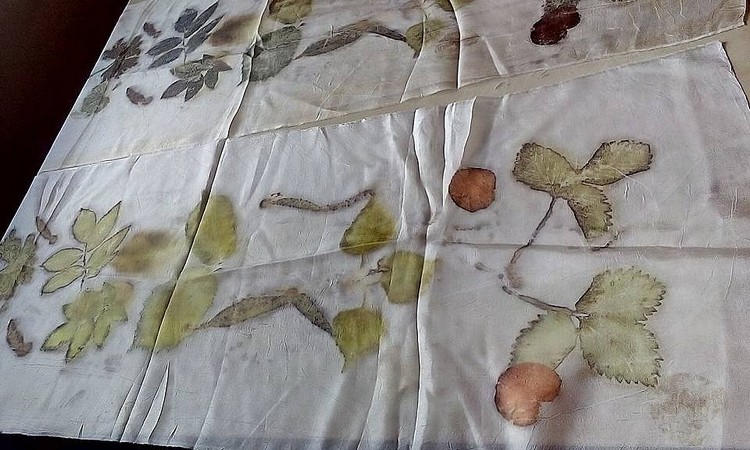 Berry eco print on fabric But syntheticfabric is better not to take. And the natural dye will not take it. You need to start work with the preparation of tissue. For several hours, it should be boiled in clean water to save material from store impregnation. As a result, the fabric becomes very soft and delicate. And then do the following:
Berry eco print on fabric But syntheticfabric is better not to take. And the natural dye will not take it. You need to start work with the preparation of tissue. For several hours, it should be boiled in clean water to save material from store impregnation. As a result, the fabric becomes very soft and delicate. And then do the following:
You can sew original pillows for the sofa from the finished fabric, which will decorate any interior. 


 If there is no time to wait long, and you want to see the result quickly, there is a way to make the imprint of plants on the fabric faster.
If there is no time to wait long, and you want to see the result quickly, there is a way to make the imprint of plants on the fabric faster.
Master class: cold print of plants on fabric
This workshop is very simple. It will be interesting to do not only for you, but also for children. For work, prepare the following materials and tools:
- various plants, for example, fern, yarrow, clover, carrot, or budra;
- a piece of plywood to cover the table;
- Cut fabric;
- parchment paper;
- a hammer;
- scissors.
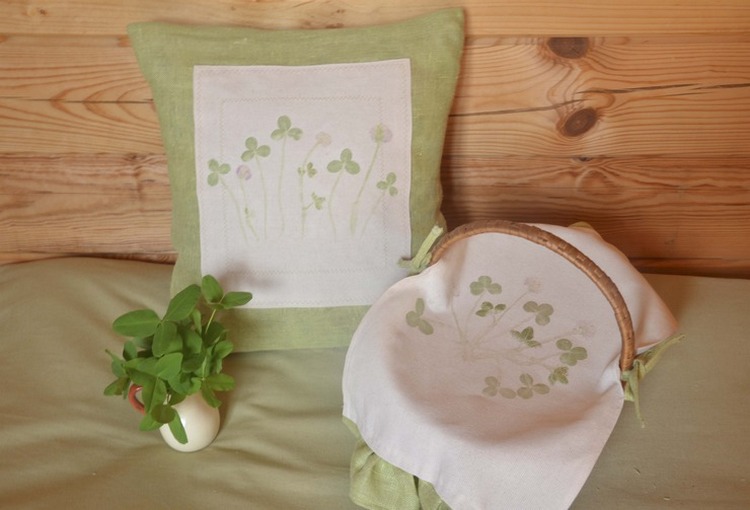 Pillow and napkin with a print of plants in a rustic interior Be sure to prepare the fabric, as well as in the hot printing method. And then everything goes quite simply:
Pillow and napkin with a print of plants in a rustic interior Be sure to prepare the fabric, as well as in the hot printing method. And then everything goes quite simply:


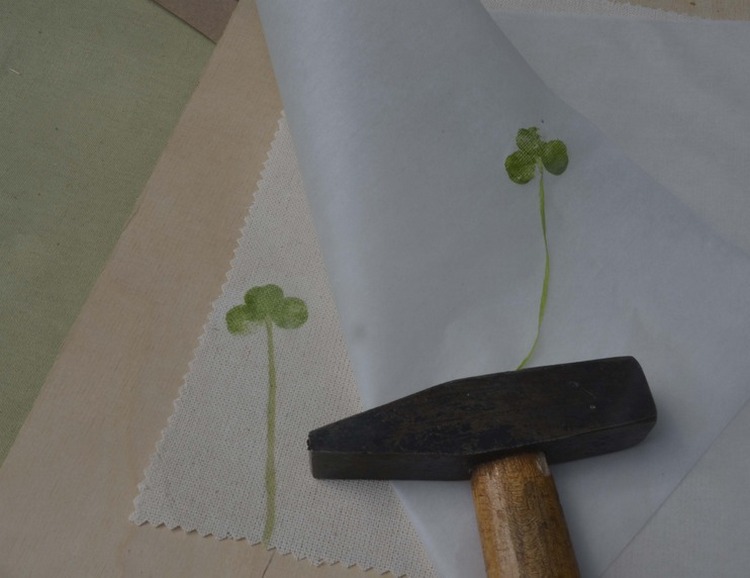
 This method has its own nuances:
This method has its own nuances:
- it is better to carry out such manipulations somewhere in the country or in nature, since the household noise and neighbors will not rejoice with the strong noise of the hammer;
- you need to beat off the plants just collected, since there is still a lot of juice in them;
- If you are going to transport the collected plants for a long time, then put them in the book for this time.
Thus, to create a unique eco interior with plant imprinting techniques, you can do:
- pillows;
- napkins;
- Easter and New Year wreaths;
- decorative bags for storing herbs and much more.

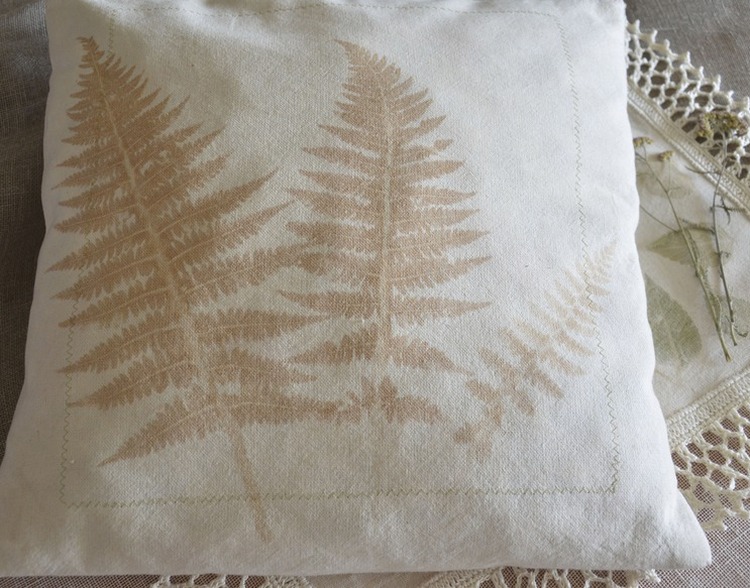

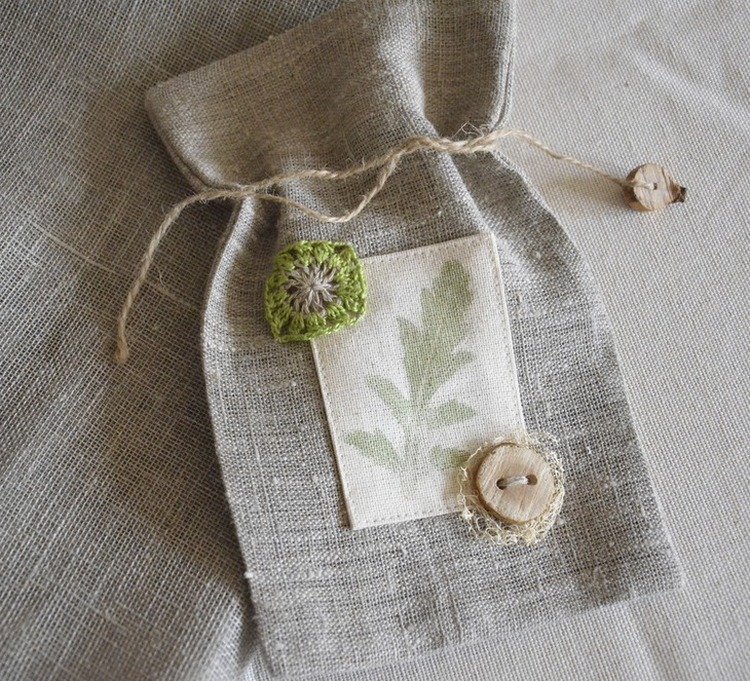
Care for natural dyed fabrics
The natural dye found in plants is very persistent. But there are several nuances for the care of such tissues:
- wash only by hands, machine washable, but with delicate conditions and water temperature no more than 30 degrees;
- wash silk with printed plants only by means special for this fabric; soft hair shampoo is allowed;
- it is necessary to wash cotton with a natural print with a detergent intended for colored linen;
- it is strictly forbidden to soak products;
- do not use chlorine products for washing;
- dry only in the shade without direct sunlight on the material.
There is another amazing technique to leave a print of plants on the fabric. 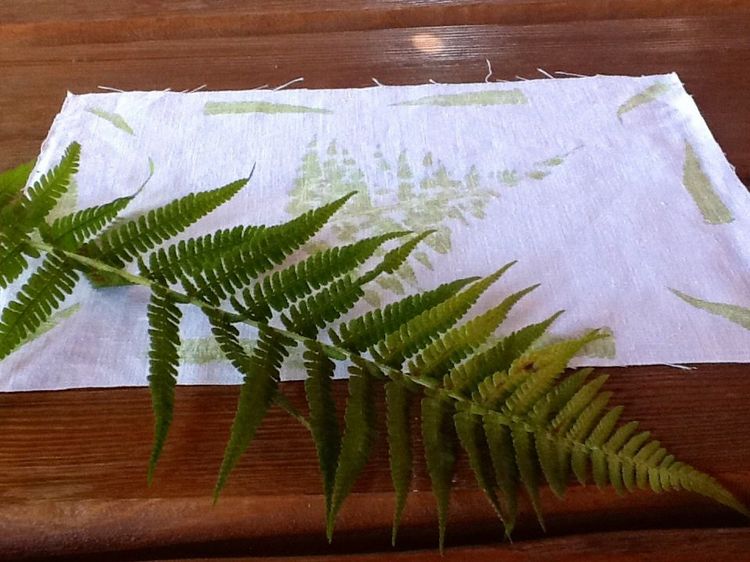 Fern imprint on fabric.
Fern imprint on fabric.
Imprint of the sun on the fabric
This is another easy way to apply eco-print to your fabric. To do this, it is best to choose the following fabrics:
- raw silk;
- velvet.
Also, other photosensitive fabrics are suitable for work. The procedure should be carried out only with dry hands, in extreme cases, it is better to wear gloves. Next, you need to do everything as follows:
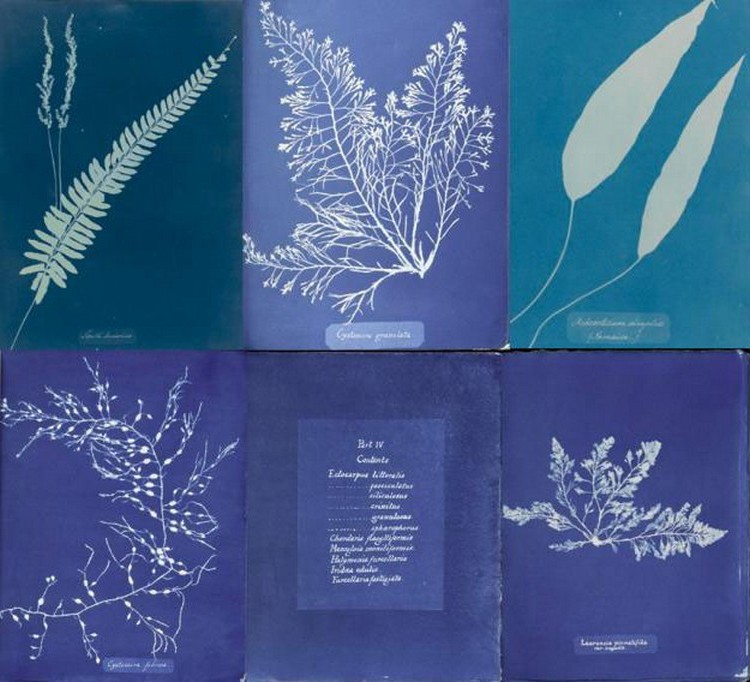 A sunny imprint on the fabric All these amazingmaster classes will help to leave an imprint of nature itself on the fabrics in the interior of your home. All this is easy and simple to do with your own hands, and as you can see, from improvised material.
A sunny imprint on the fabric All these amazingmaster classes will help to leave an imprint of nature itself on the fabrics in the interior of your home. All this is easy and simple to do with your own hands, and as you can see, from improvised material. 






 We also recommend viewing:
We also recommend viewing:
Do you like the article? Share on social networks!




